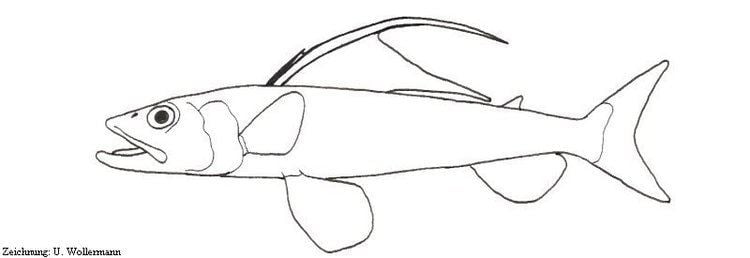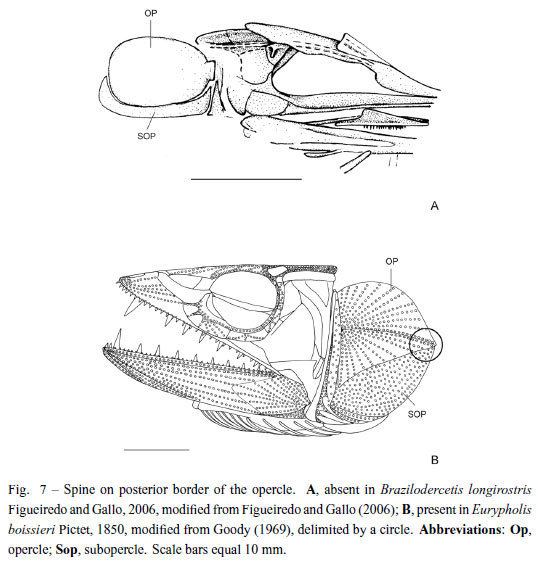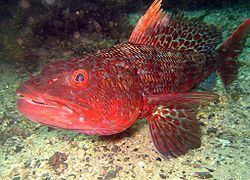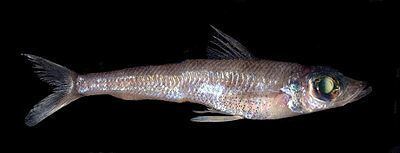Infraclass Teleostei Phylum Chordata Rank Order | Superclass Osteichthyes Scientific name Aulopiformes Higher classification Teleost Subclass Neopterygii | |
 | ||
Superorder Cyclosquamata (disputed) Lower classifications Synodontidae, Lancetfish, Telescopefish, Bathysauridae, Sabertooth fish | ||
Aulopiformes is a diverse order of marine ray-finned fish consisting of some 15 extant and several prehistoric families with about 45 genera and over 230 species. The common names grinners, lizardfishes and allies or aulopiforms are sometimes used for this group. The scientific name means "Aulopus-shaped", from Aulopus (the type genus) + the standard fish order suffix "-formes". It ultimately derives from Ancient Greek aulós (αὐλός, "flute" or "pipe") + Latin forma ("external form"), the former in reference to the elongated shape of many aulopiforms.
Contents

They are grouped together because of common features in the structure of their gill arches. Indeed, many authors have considered them so distinct as to warrant separation in a monotypic superorder of the Teleostei, under the name Cyclosquamata. However, monotypic taxa are generally avoided by modern taxonomists if not necessary, and in this case a distinct superorder seems indeed unwarranted: together with the equally dubious superorder "Stenopterygii", the grinners appear to be so closely related to some Protacanthopterygii to be included in that superorder. In particular, this group might be the sister taxon of the Salmoniformes (salmon, trout, and relatives). As an alternative, the superorders are sometimes united as an unranked clade named Euteleostei, but in that case the Protacanthopterygii would need to be split further to account for the phylogenetic uncertainty. This would result in a highly cumbersome and taxonomically redundant group of two very small and no less than four monotypic superorders.

Description

Many aulopiforms are deep-sea fishes, with some species recognized as being hermaphrodites, some with the ability to self-fertilise. Some are benthic, but most are pelagic nekton. In general, aulopiform fish have a mixture of advanced and primitive characteristics relative to other teleost fish.

Aulopiforms have either a vestigial gas bladder, or lack it entirely, a hypaxialis muscle that is unusually extended to forward at its upper end and attaches to the neurocranium below the spine (perhaps to snap the upper part of the skull down when catching prey) and the position of the maxillary bone. Their second pharyngobranchial is greatly elongated posterolaterally away from third pharyngobranchial, which lacks a cartilaginous condyle to articulate with the preceding, but is contacted by the elongated uncinate process of the second epibranchial. Other features include the position of the pelvic fins far back on the body, the fused medial processes of pelvic girdle and the presence of an adipose fin (which is also typical for the Protacanthopterygii).
The larvae of some Aulopiformes are extremely bizarre-looking, with elongated fins, and do not resemble the adult animals. They were not only described as distinct species, but also even separated as genera and finally in a family "Macristiidae" which was allied with various Protacanthopterygii (sensu lato). But the initial assessment – which found "Macristium" to resemble the deepwater lizardfishes (Bathysauridae) in some details – was not far off the mark: "Macristium" species are larvae of Bathysaurus, while the supposed other "macristiids", "Macristiella" species are larvae of the deepsea tripodfish Bathytyphlops.
